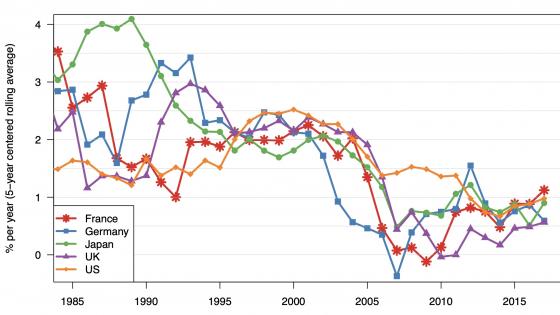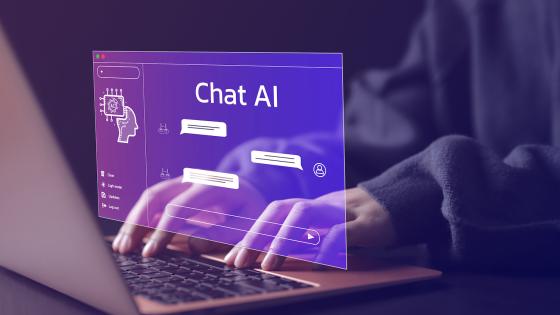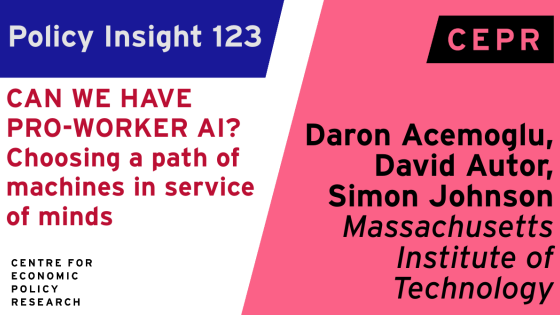Income and wellbeing gains in advanced economies have been held back by weak productivity performance. The growth rate of labour productivity declined in OECD economies from about 2% annual growth rate between the 1970s and 1990s, to 1% in the 2000s (Goldin et al. 2024, Andre and Gal 2024). This poses a dramatic challenge for ageing societies and makes it harder to allocate resources for the green transition.
There is widespread enthusiasm about the growth potential of rapidly developing artificial intelligence (AI). Some analysts argue that, under reasonable conditions, AI could lead to large and persistent gains, on the order of adding 1–1.5 percentage points to annual growth rates over the next 10–20 years (Baily et al. 2023, Artificial Intelligence Commission of France 2024, McKinsey 2023, Briggs and Kodnani 2023). On the other hand, Acemoglu (2024) contends that the available evidence combined with the economic theory of aggregation supports only moderate total factor productivity and GDP growth impacts, on the order of about 0.1% per year.
Recent work from the OECD provides a broad overview of AI’s impact on productivity and discusses the conditions under which it is expected to deliver strong benefits, with a focus on the role of policies (Filippucci et al. 2024).
AI as a new general-purpose technology
Given its transformative potential in a wide range of economic activities, AI can be seen as the latest general-purpose technology (Agrawal et al. 2019, Varian 2019) – similar to previous digital technologies such as computers and the internet or, going back further, to the steam engine and electricity. From an economic perspective, AI can be seen as a production technology combining intangible inputs (skills, software, and data) with tangible ones (computing power and other hardware), to produce three broad types of outputs:
- Content, such as texts or images (generative AI)
- Predictions, optimisations, and other advanced analytics, which can be used to assist with or fully automate human decisions (non-generative AI)
- Physical tasks when combined with robotics (including autonomous vehicles).
Additionally, AI has some peculiar features, even compared to previous digital technologies. These include the potential for being autonomous (less dependent on human inputs) and the capacity for self-improvement, by learning from patterns in unstructured data or leveraging feedback data about its own performance. Altogether, these features imply that AI can boost not only the production of goods and services but also the generation of ideas, speeding up research and innovation (Aghion et al. 2018).
Initial micro-level evidence shows large productivity and performance gains
According to our overview of the fast-growing literature, initial micro-level evidence covering firms, workers, and researchers is indicative of several positive effects from using AI. First, micro-econometric studies find that the size of the gains from non-generative AI on firms’ productivity is comparable to previous digital technologies (up to 10%; see panel a of Figure 1). Second, when using more recent generative AI in various tasks – assisting in writing, computer programming, or customer service requests – the estimated performance benefits are substantially larger but vary widely (between 15 and 56%; see panel b of Figure 1) depending on the context. In particular, Brynjolfsson et al. (2023) found that AI has a much stronger impact on the performance of workers with less experience in their job. These estimates focus on specific tasks and individual-level gains. Hence, they are narrower in scope than previous firm-level studies but tend to rely more on more causal identification in experimental settings.
Figure 1 The positive relationship between AI use and productivity or worker performance: Selected estimates from the literature
a) Non-generative AI, firm-level studies on labour productivity
b) Generative AI, worker-level studies on performance in specific tasks
Note: In panel a, ‘AI use’ is a 0-1 dummy obtained by firm surveys, while ‘AI patents’ refers either to a 0-1 dummy for having at least one patent (US study) or to the number of patents in firms. The sample of countries underlying the studies are shown in parentheses. The year(s) of measurement is also indicated. *Controlling for other ICT technologies. For more details, see Filippucci et al. (2024).
Third, researchers believe that AI allows for faster processing of data – speeding up computations and decreasing the cost of research – and may also make new data sources and methods available, as documented by a recent survey in Nature (Van Noorden and Perkel 2023). Fourth, AI-related inventions are cited in a broader set of technological domains than non-AI inventions (Calvino et al. 2023). Finally, there are promising individual cases from specific industries: AI-predicted protein-folding gives new insights in biomedical applications; AI-assisted discoveries of new drugs help with pharmaceutical R&D; and research on designing new materials can be broadly used in manufacturing (OECD 2023).
Long-run aggregate gains are uncertain
As generative AI’s technological advances and its use are very recent, findings at the micro or industry level mainly capture the impacts on early adopters and very specific tasks, and likely indicate short-term effects. The long-run impact of AI on macro-level productivity growth will depend on the extent of its use and successful integration into business processes.
According to official representative data, the adoption of AI is still very low, with less than 5% of firms reporting the use of this technology in the US (Census Bureau 2024; see Figure 2). When put in perspective with the adoption path of previous general-purpose technologies (e.g. computers and electricity), AI has a long way to go before reaching the high adoption rates that are necessary to detect macroeconomic gains. While user-friendly AI may spread faster through the economy, the successful integration of AI systems and exploiting their full potential may still require significant complementary investments (in data, skills, reorganisations) which take time and necessitate managerial talent. Moreover, future advances in AI development – and its successful integration within business processes – will require specialised technical skills that are often concentrated within a few firms (Borgonovi et al. 2023).
Figure 2 AI adoption is still limited compared to the spread of previous general-purpose technologies
The evolution of technology adoption in the US (as % of firms)
Note: The 2024 value for AI is the expectation (exp.) as reported by firms in the US Census Bureau survey. For more details, see the sources.
Source: For PC and electricity, Briggs and Kodnani (2023); for AI, US Census Bureau, Business Trends and Outlook Survey, updated 28 March 2024.
It is also an open question whether AI-driven automation will displace (reallocate) workers from heavily impacted sectors to less AI-affected activities or the human-augmenting capabilities of AI will prevail, underpinning labour demand. Currently, AI exposure varies greatly across sectors: knowledge-intensive, high-productivity activities are generally much more affected (Figure 2), with significant potential for automation in some cases (Cazzaniga et al. 2024, WEF 2023). Hence, an eventual fall in the employment shares of these sectors would act as a drag on aggregate productivity growth, resembling a new form of ‘Baumol disease’ (Aghion et al. 2019).
Figure 3 High-productivity and knowledge-intensive services are most affected by AI
AI exposure of workers by sector, 2019
Note: The index measures the extent to which worker abilities are related to important AI applications. The measure is standardised with mean zero and standard deviation one at the occupation level and then matched to sectors. Figure does not yet include recent Generative AI models. *Including non-market services, manufacturing, utilities, etc.
Source: Filippucci et al. (2024) and OECD (2024) based on Felten et al. (2021).
Historically, the automation of high-productivity activities, combined with saturating demand for their output, has pushed employment from manufacturing to services (Bessen 2018). This structural change also played a role – though a moderate one – in the ongoing slowdown in aggregate productivity growth (Sorbe et al. 2018). Similarly, if AI enhances productivity only in selected activities, aggregate growth will be limited by the slower productivity growth and higher employment share in sectors that are less exposed to AI (such as labour-intensive personal services like leisure and health care). This may occur more quickly with AI compared to past technologies given the rapid and wide-ranging advances in its capabilities. However, in the extreme case of AI impacting (nearly) all tasks and boosting productivity in (nearly) all economic activities, this negative effect may be muted (Trammel and Korinek 2023).
AI poses policy challenges related to competition, inequality, and broader societal risks
AI poses significant threats to market competition and inequality that may weigh on its potential benefits, either directly or indirectly, by prompting preventive policy measures to limit its development and adoption.
First, the high fixed costs and returns to scale related to data and computing power may lead to excessive concentration of AI development. Second, AI use in downstream applications may lead to market distortions, especially if it allows first movers to build up a substantial lead in market share and market power. Moreover, AI-powered pricing algorithms have a tendency to charge supra-competitive prices (Calvano et al. 2020) and could eventually enhance harmful price discrimination (OECD 2018).
The impact of AI on inequality remains ambiguous. The technology can potentially substitute for high-skilled labour and narrow wage gaps with low-skilled workers, thereby reducing inequalities (Autor 2024) at least within occupations (Georgieff 2024). Though there are indications that AI can be associated with higher unemployment (OECD 2024), AI could also lead to more inclusion and stronger economic mobility by improving education quality and access, expanding credit availability, and lowering skill barriers (e.g. foreign languages).
Further uncertainties surrounding AI include broader societal concerns. More immediate concerns relate to privacy, misinformation, and bias (possibly leading to exclusion in areas such as labour and financial markets), while longer-term concerns include mass unemployment or even existential risks (Nordhaus 2021, Jones 2023).
A comprehensive policy approach is needed to effectively manage these risks and harness AI's full potential. Immediate priorities include promoting market competition and widespread access to AI technologies while preserving innovation incentives (e.g. via adapting intellectual property rights protection) and addressing issues of reliability and bias, which require adequate auditing and accountability mechanisms. Job displacement, reallocation and inequality impacts might emerge over longer periods, but they require preventive policy action through training, education, and redistribution measures to ensure human skills remain complementary to AI. Policymakers should also devise national and international governance mechanisms to cope with rapid and unpredictable developments in AI.
Authors’ note: The main paper underlying this column (Filippucci et al. 2024) was developed within the Joint OECD-Italy’s Department of Treasury Project for Multilateral Policy Support.
References
Acemoglu, D (2024), “The Simple Macroeconomics of AI”, MIT, 5 April.
Acemoglu, D and T Lensman (2023), “Regulating Transformative Technologies”, NBER Working Paper 31461, July.
Aghion, P, B Jones and C Jones (2018), “Artificial Intelligence and Economic Growth”, NBER Working Paper 23928, October.
Agrawal, A, J Gans and A Goldfarb (2019), “Economic Policy for Artificial Intelligence”, Innovation Policy and the Economy, vol. 19.
Andre, C and P Gal (2024), “Reviving productivity growth: A review of policies”, OECD Economic Policy Papers, forthcoming.
Artificial Intelligence Commission of France (2024), “AI, Our Ambition for France” (“IA : Notre Ambition pour la France”), March.
Autor, D (2024), “Applying AI to Rebuild Middle Class Jobs”, NBER Woking Paper 32140, February.
Baily, M, E Brynjolfsson and A Korinek (2023), “Machines of mind: The case for an AI-powered productivity boom”, The Economics and Regulation of Artificial Intelligence and Emerging Technologies, Brookings, 10 May.
Bessen, J (2018), “AI and Jobs: The Role of Demand”, NBER Working Paper 24235, January.
Borgonovi, F et al. (2023), “Emerging trends in AI skill demand across 14 OECD countries”, OECD Artificial Intelligence Papers, no. 2, Paris: OECD Publishing.
Briggs, J and D Kodnani (2023), “The Potentially Large Effects of Artificial Intelligence on Economic Growth”, Global Economics Analyst, New York: Goldman Sachs.
Brynjolfsson, E, D Li and L Raymond (2023), “Generative AI at Work”, NBER Working Paper 31161, November.
Calo, R (2013), “Digital market manipulation”, The George Washington Law Review 82/995.
Calvano, E et al. (2020), “Artificial intelligence, algorithmic pricing, and collusion”, American Economic Review 110(10): 3267–97.
Calvino, F and L Fontanelli (2023), “A portrait of AI adopters across countries: Firm characteristics, assets’ complementarities and productivity”, OECD Science, Technology and Industry Working Papers, no. 2, Paris: OECD Publishing.
Cazzaniga, M et al. (2024), “Gen-AI: Artificial Intelligence and the Future of Work”, IMF Staff Discussion Notes, International Monetary Fund, 14 January.
Census Bureau (2024), Business Trends and Outlook Survey, 28 March.
Felten, E, M Raj and R Seamans (2021), “Occupational, industry, and geographic exposure to artificial intelligence: A novel dataset and its potential uses”, Strategic Management Journal 42(12): 2195–217.
Filippucci, F, P Gal, A Leandro, C Jona-Lasinio and G Nicoletti (2024), “The impact of Artificial Intelligence on productivity, distribution and growth: Key mechanisms, initial evidence and policy challenges”, OECD Artificial Intelligence Papers, no. 15, Paris: OECD Publishing.
Georgieff, A (2024), “Artificial intelligence and wage inequality”, OECD Artificial Intelligence Papers, no. 13, Paris: OECD Publishing.
Goldin, I, P Koutroumpis, F Lafond and J Winkler (2024), “Why Is Productivity Slowing Down?”, Journal of Economic Literature 62(1): 196–268.
Haslberger, M, J Gingrich and J Bhatia (2023), “No great equalizer: experimental evidence on AI in the UK labor market”, SSRN, 2 November.
Jones, C (2023), “The A.I. Dilemma: Growth versus Existential Risk”, NBER Working Paper 31837, November.
McKinsey (2023), “The economic potential of generative AI”, McKinsey Digital, 14 June.
Nordhaus, W (2021), “Are We Approaching an Economic Singularity? Information Technology and the Future of Economic Growth”, American Economic Journal: Macroeconomics 13(1): 299–332.
OECD (2018), “Personalised Pricing in the Digital Era”, Background Note by the OECD Secretariat for the joint meeting between the Competition Committee and the Committee on Consumer Policy, 28 November.
OECD (2024), “Labour Market Shortages, Mismatches and Megatrends”, OECD Global Forum on Productivity, forthcoming.
OECD (2023), Artificial Intelligence in Science: Challenges, Opportunities and the Future of Research, Paris: OECD Publishing, June.
Sorbe, S, P Gal and V Millot (2018), “Can productivity still grow in service-based economies? Literature overview and preliminary evidence from OECD countries”, OECD Economics Department Working Papers, no. 1531, Paris: OECD Publishing.
Trammell, P and A Korinek (2023), “Economic Growth under Transformative AI”, NBER Working Paper 31815, October.
Van Noorden, R and J Perkel (2023), “AI and science: what 1,600 researchers think”, Nature 621(7980): 672–75.
WEF (2023), “Jobs of Tomorrow: Large Language Models and Jobs”, World Economic Forum White Papers, September.











